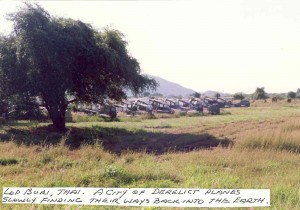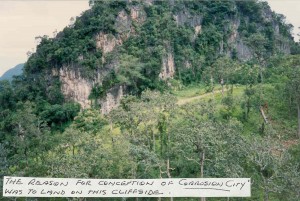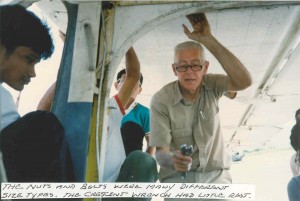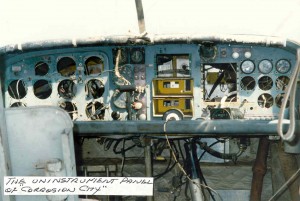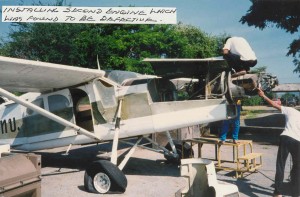By Jack and Wilma Bradley
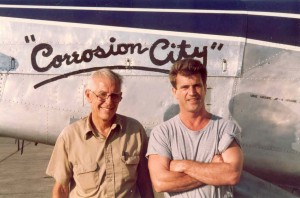
Tom Danaher (left) in Thailand with Mel Gibson, star of “Air America.” In the background is Corrosion City, a plane Danaher assembled from junk parts and flew in the movie.
Tom Danaher has done it all. Born in 1924, he would be just the right age to join the military during World War II. He graduated from high school in Dallas in 1941 and had to wait until he turned 18 to join the Navy V5 pilot training program. He trained in an F4U Corsair and became a Marine Corps fighter pilot, flying night fighter missions in a Grumman F6F-5N Hellcat. Ground based radar would pick up incoming enemy planes and would vector the fighters to intercept.
“When you were lower, you could see them against the night sky; the Milky Way was our friend,” he said. “You would be given permission to shoot only after you got close and made a positive visual ID.”
He made history in August 1945, while stationed on Okinawa. He shot down the last Japanese bomber on the final night of World War II. In the eight nights before the cease-fire, Danaher, 21, downed three Japanese “Betty” bombers.
Following the war, Danaher was sent to Japan as part of the occupation force. There he met Yoshio Shiga, who had served Japan as the leader of the Zero fighters against Pearl Harbor, on Dec. 7, 1941. He and Shiga corresponded regularly until Shiga’s death at 91 on Nov. 25, 2005.
After his discharge, Danaher arrived home in Wichita Falls, Texas, on Christmas Eve 1945. He began crop dusting in Navy N3N biplane trainers with Marine pilot friend George Conner in Jennings, La.
In 1951, Danaher was recalled to active duty, flying with the Marines in Korea. He flew the F3D Skynight, one of the earliest jets, on night combat air patrols and as fighter escort for B-29 night bombing missions. He flew escort on the last combat mission flown by the venerable B-29s, a high altitude bombing strike over Pyongyang, North Korea, on July 26, 1953.
After returning from Korea in 1953, he went to Utah with his older brother Jim, a WWII P-38 combat pilot, to prospect for uranium. When the Atomic Energy Commission withdrew guaranteed purchase of uranium oxide in 1954, Danaher decided to fly his 1948 185-hp Bonanza to England to visit his RAF friends he had met in Korea. He built a 109-gallon auxiliary fuel tank, flew to NAS Argentia, Newfoundland, refueled and flew straight across the Atlantic, via the great circle route, to Shannon, Ireland. He went from Shannon to England, visited his RAF friends and then flew on to Rome for an audience with Pope Pius XII.
While in England, he became involved with an unusual radio station. During the 1960s, the BBC controlled English radio, and the programming was mostly chamber music. Danaher helped build a 17,000-watt “pirate” station on a surplus WWII minesweeper and anchored it just beyond Britain’s territorial limit, three and a half miles off southeast England.
“We had someone in Dallas who would record KLIF, a top 40 station, and we put it right on the air,” Danaher said. “The Englishmen over there just ate it up. The name of our station was Wonderful Radio London. The station programmed news and top 40 music and was very successful. It had the largest listening audience of any commercial broadcast station at that time.
In 1963, Danaher bought a Navy surplus Grumman Goose amphibian, located at the base where he had been stationed in Japan in 1945. He wanted to fly it north across the Bering Strait to Alaska, then home to Texas. Even after exchanging several cablegrams with Khrushchev’s office in Moscow, he wasn’t able to get confirmed clearance to fly across Russian territory. Finally, he arranged to have the plane shipped to California, and he flew it home from there. He and his friends overhauled the engines and did considerable work on the airframe.
Danaher owned and operated three Wichita Falls car dealerships, but sold them in 1972 to open his own airport, Tom Danaher Airport, also known as Lake Wichita Airport (7TXO), in Texas. The airport has a 3,800-foot paved runway and a VOR-DME approach.
Danaher has flown in about two dozen movies. The first, “Fire Power,” starred Sophia Loren, James Coburn and O.J. Simpson. Others include “Empire of the Sun,” “Out of Africa,” “Air America,” “Death Hunt,” “White Hunter Black Heart,” “Cliffhanger,” “GoldenEye” and a number of British and French films.
During a flight down the Amazon for the IMAX documentary, “Amazon,” Danaher had to find fuel for his Grumman Goose at boat docks and auto gas stations. The Goose’s engines were designed to use 80 octane avgas, and were also compatible with 84 octane automobile/ boat gasoline. He carried 14 five and 10 gallon cans, which he and copilot Scott Herring wheeled to towns, looking for fuel to fill the Goose.
The IMAX filming lasted about seven weeks, during which time Danaher flew the 61-year-old Goose more than 13,000 miles, going as far south as Lima, Peru. At about 125 knots, that measures more than 100 hours. One filming scene required the Goose to be flown to 21,100 feet over the Andes Mountains.
“Air America” told the story about a U.S. operation that supplied a secret mercenary army in Laos, for more than a decade. The script called for Danaher to land a Pilatus Porter on a very short strip, built into the side of a mountain. The Porters used in filming had been leased from the Thai military, and its government refused to let Danaher fly one of their Porters for the mountain landing.
“They were afraid I’d crack it up,” he said.
“I heard that the CIA had given 10 Porters to the Thai army when Air America ceased operations. The army cannibalized one plane after another, until all they had left was a junkyard of corroding parts,” Danaher said.
At Lop Buri, Thailand, he found the Porters’ remains. Danaher and a small crew from the Thai army assembled a Porter from what remained of the aircraft, which had flown in combat over Laos and Cambodia during the Vietnam War. The last one had flown 10 years earlier, in 1980.
Two weeks after the project began, the assembled aircraft was named Corrosion City, and Danaher flew it from the construction site to the mountainside. He made the approach with high power, flying well below power-off stall speed, in order to make the very short uphill field. He then flew it off the mountainside.
“That part wasn’t in the script, but they put it in the movie anyway,” he explained.
Danaher has about 26,000 hours in many different types of aircraft. They range from World War I replicas to the Jetstar he flew in “Cliffhanger.” In addition to his military and movie flying, he has flown Air Tractors for his longtime friend, Leland Snow, president of Air Tractor, Inc. He conducted production test flying and flew ferry flights to deliver Air Tractors to South America, Africa, the Middle East and Europe.
Danaher was certified 52 years ago as an A&E mechanic, and has inspection authorization. Many of his delivery trips included teaching the new owners how to maintain the aircraft.
When asked how many Atlantic Ocean crossings he had made in small aircraft, he said he stopped counting at more than 100, and that was some years ago. He’s never kept a logbook. He also said if GPS had been invented 50 years ago, he wouldn’t have a gray hair on his head.
Tom Danaher is not your run-of-the-mill pilot. To meet and visit with him is a treasured memory you’ll never forget. He’s a true legend of modern aviation.












